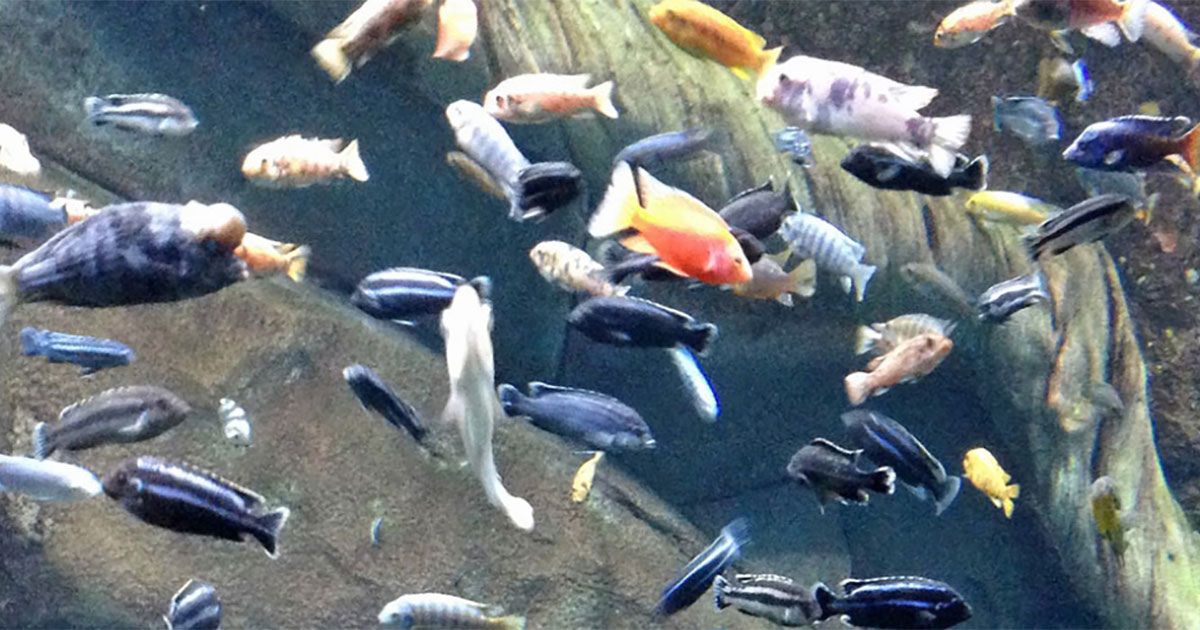Scientists show the extraordinary diversity of cichlid fish in Africa’s Lake Victoria was made possible by ‘genetic recycling’—repeated cycles of new species appearing and rapidly adapting to different roles in the ecosystem.
In an evolutionary case study that has fascinated researchers for decades, the research sheds light on how 500 species of fish were able to emerge and thrive in just 16,000 years.
By comparing genomes of hundreds of present-day cichlid fish species, researchers from a multinational team, led by Joana Meier and Ole Seehausen from the Swiss water research institute Eawag, the University of Bern, the University of Cambridge and the Wellcome Sanger Institute, showed that hybridization—where two different species come together and merge their genes to create a new species with a mix of characteristics from both parent types—enabled cichlids to do so well. The research team also identified unique ancient genes that spurred on this process.
The findings, published in Science, reveal the reasons behind cichlids’ unique ecological diversity. They also provide important insights into the genetic basis of adaptive evolution and diversification.
Cichlids in Lake Victoria have adapted to occupy nearly every imaginable role in the ecosystem. They come in various sizes, shapes, colors, ranging from top predators down to tiny zooplankton. These cichlids are considered a classic example of ‘adaptive radiation,’ where one group gives rise to many species, each with unique characteristics and behaviors. It was unclear whether this diversification occurred solely within Lake Victoria, an astonishingly rapid process of around 16,000 years, following a 4,000-year dry period. This pace far exceeds that of Darwin’s finches, which took millions of years to evolve 14 species.
In this new study, the research team set out to investigate if these cichlids indeed evolved extremely rapidly within the lake, and if so, how they were able to do so. As part of this, they tested whether Lake Victoria cichlids really are distinct species1 and the genetic factors that underpinned this unprecedented scale of evolution.
The team analyzed 464 whole genomes of modern cichlids from Lake Victoria and the wider Great African Lakes region. The findings confirmed cichlids found in the lake are indeed separate species evolved from the same mix of genes, having evolved within Lake Victoria after the dry period through a common hybridization event. Their evolutionary history is marked by repeated “genetic recycling”—periods where different groups of fish mated and mixed their genes followed by them eventually separating into new species.
Researchers determined that around 16,000 years ago, when the lake refilled, three swamp-dwelling cichlid populations came together, merging their genes to give rise to hybrid fish. The initial genetic diversity in these three cichlid populations2 played a crucial role in their potential to evolve ecological groups. Each swamp population contributed different gene variants, such as genes for hunting or algae scraping.
By mixing their genes, they generated a large amount of genetic diversity, a faster mechanism than waiting for new mutations to accumulate slowly. The hybrids developed different behaviors, each occupying distinct ecological roles like hunting, algae-scraping, zooplankton sifting and insect eating, while mostly breeding within their groups. This led to the rapid formation of various species.
Despite these adaptive differences, their close genetic relationship allowed for ongoing episodes of hybridization, creating even more genetic combinations. For instance, the combination of genes from large predators and small zooplanktivores gave rise to a new ecological group of dwarf predators, combining the predatory lifestyle with the small body size of zooplanktivores.
Professor Ole Seehausen, senior author of the study, Professor of the University of Bern and the Swiss water research Institute EAWAG said: “Thanks to cycles of hybridization and diversification, countless variations in inherited traits have been preserved that have accumulated in these cichlid populations for millions of years. Species today hold in their genomes the potential for rapid “reconstruction” of incredibly advantageous specializations. Our findings emphasize the importance, in conservation biology, of considering the connections between species, both genetically and ecologically, rather than viewing them in isolation. By preserving diverse species, we retain a resource pool that can help them adapt to environmental changes, such as coping with rising temperatures through occasional hybridization and sharing adaptations.”
Dr. Joana Meier, first author of the study and group leader at the Wellcome Sanger Institute said: “Hybridization might be more prevalent—and important—in nature than we previously thought. Genomics can reveal these secrets. As we explore reasons behind the remarkable success of these fish and in my ongoing work across the tree of life, we are glimpsing the very cogs and wheels of evolution—insights that may help researchers decode the origins of all manner of species.”
More information
- Previous attempts using mitochondrial analysis were inconclusive in determining the species status of Lake Victoria cichlids. This uncertainty arose from their relatively recent divergence, occurring only 16,000 years ago, which resulted in limited genetic differences in mitochondrial DNA and a lack of robust statistical support. Genomic approaches, in contrast, examine the full spectrum of genes and DNA sequences, offering a broader array of genetic markers and variations for researchers to assess, providing a more accurate and comprehensive understanding of the cichlids’ genetic relationships.
- The study also suggests that the three founding lineages themselves are hybrids from an older hybridization event 350,000 years ago.
The authors dedicate the paper to colleague, collaborator, and friend, Sylvester Bwaku Wandera who sadly passed away weeks before publishing. Wandera was a chief taxonomist at Uganda’s National Fisheries Resources Research Institute who studied cichlids and other fish in the region, discovering many species.
Publication:
J.I. Meier et al. (2023) Cycles of fusion and fission enabled rapid parallel adaptive radiations in African cichlids. Science. DOI: 10.1126/science.ade2833



